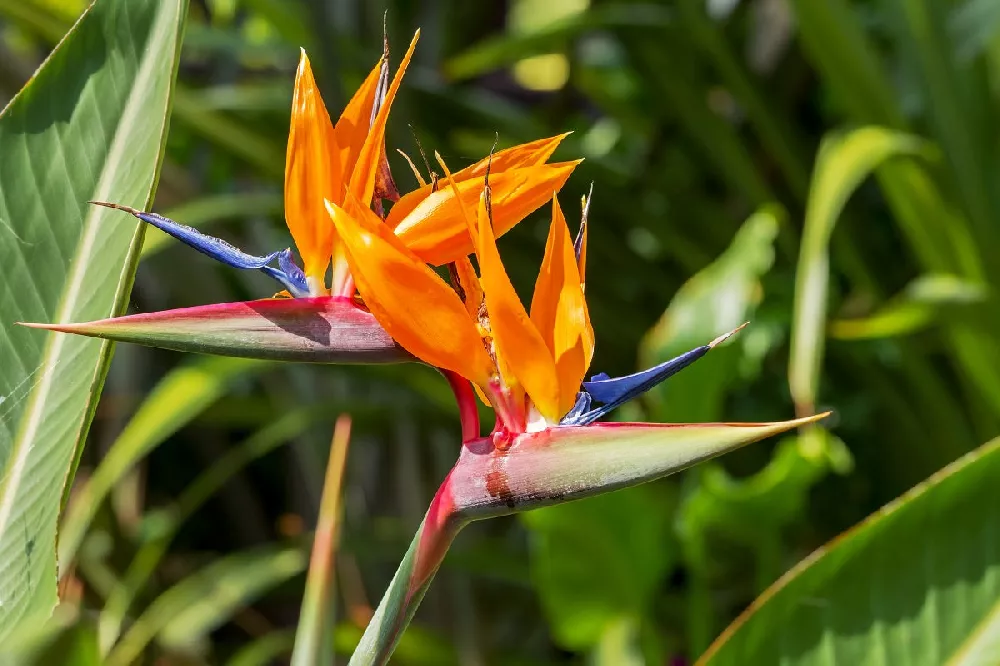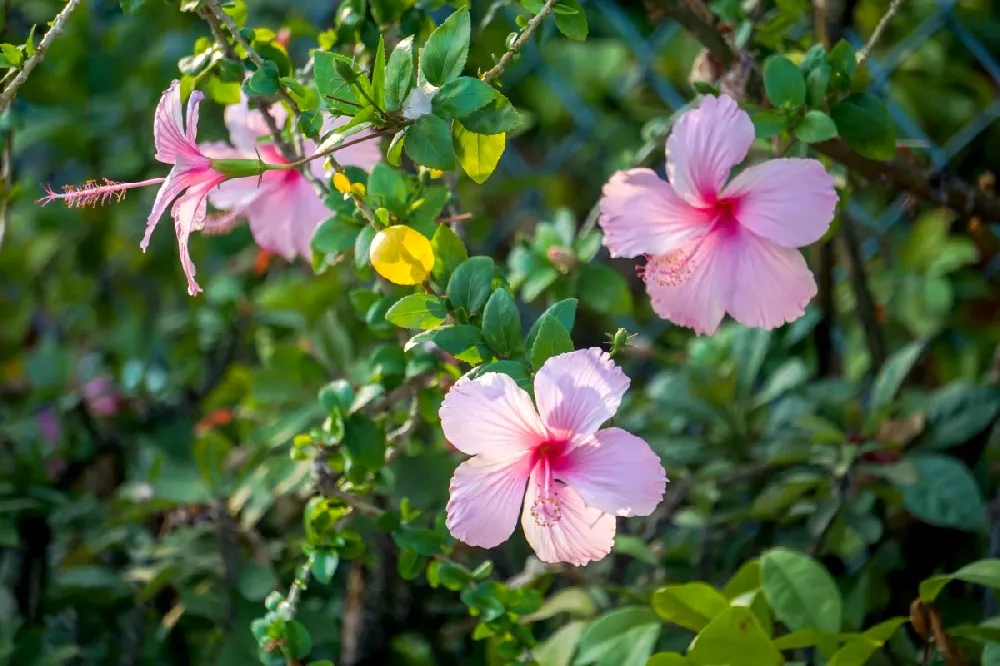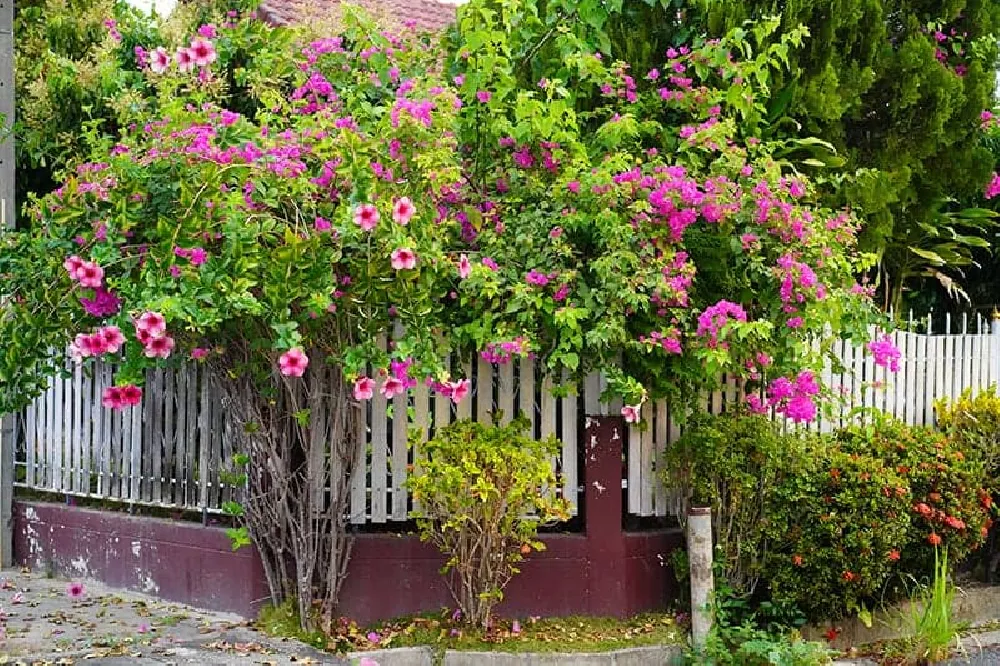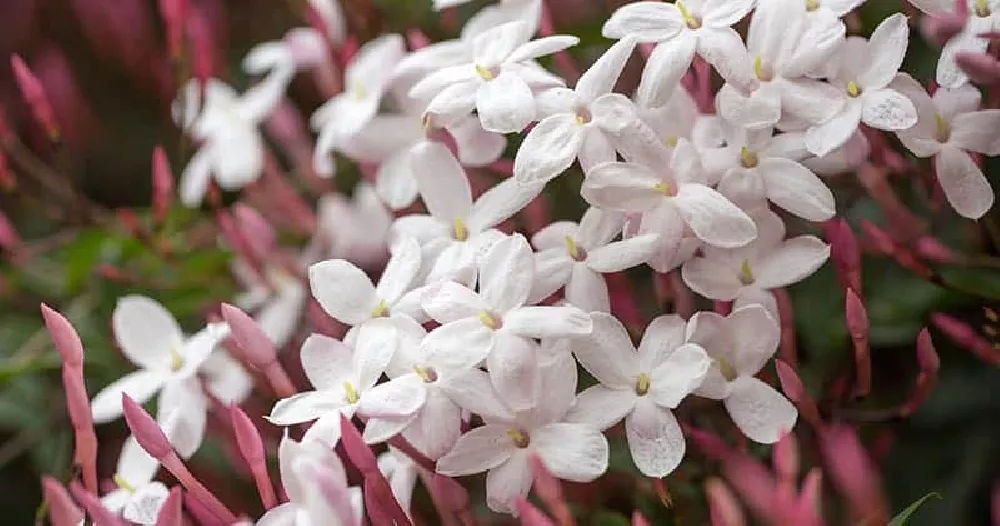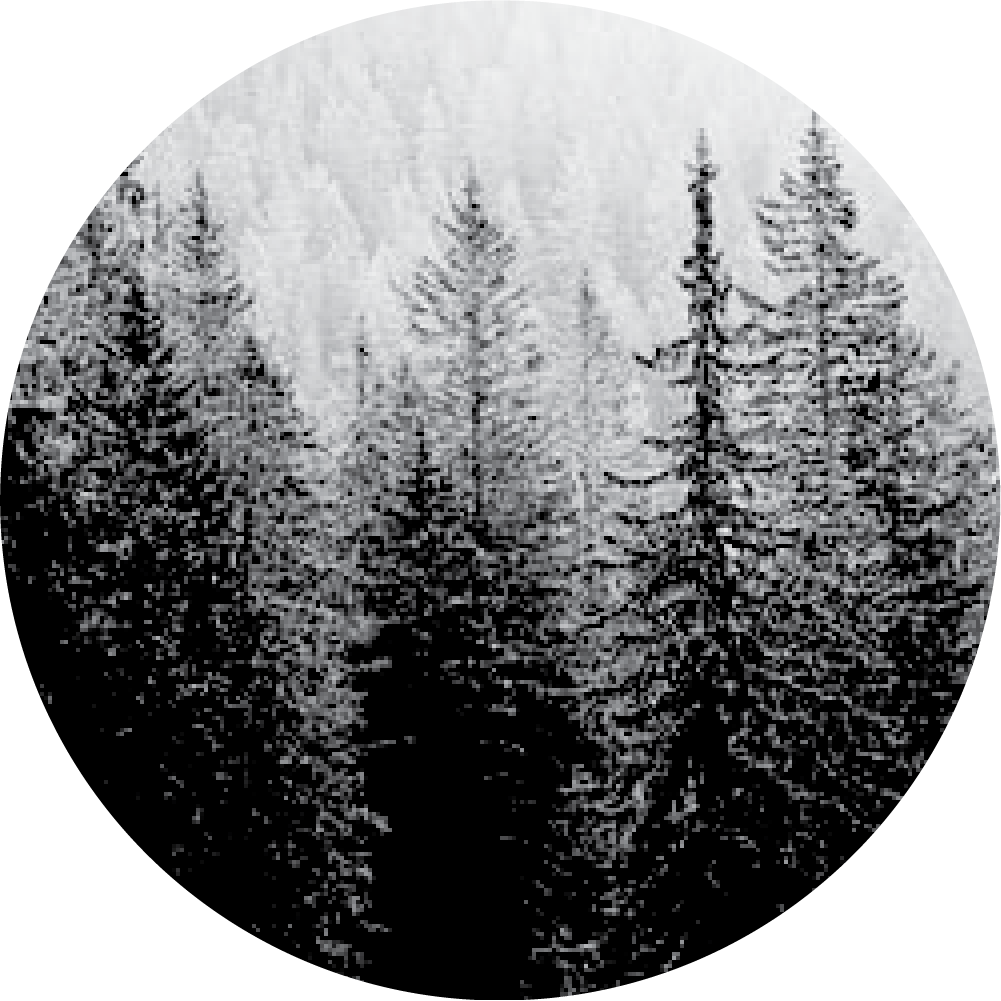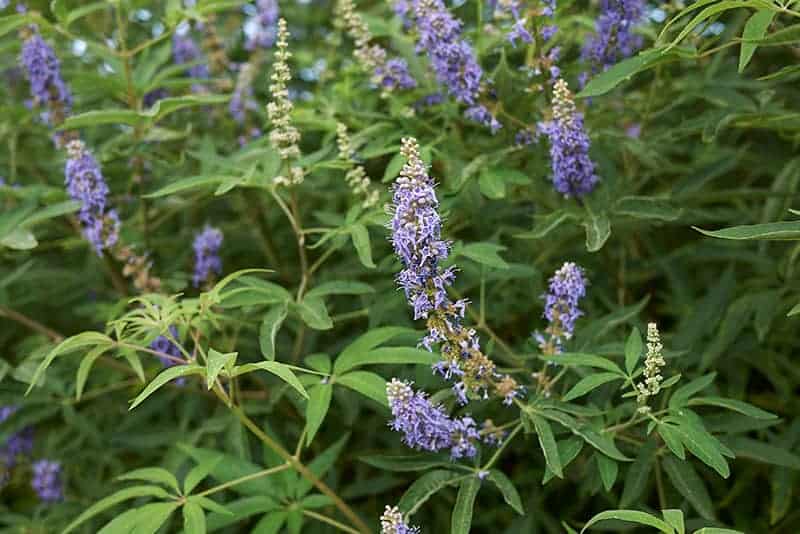Tropical Flowers for Sale - Buying & Growing Guide
Filters
Price Range
Growing Zones
Plant Type
Flower Color
Sunlight
Mature Height
Plant Characteristics
5 Results
Tropical Flowers – Buying & Growing Guide
Tropical flowers are those that are native to tropical locations, typically those that are located close to the equator, and though they require typically hot and humid climates to thrive, they can also grow well as houseplants or when kept in greenhouses. Tropical flowers can also be grown as annuals in warm summer regions and can bring a wonderfully bright and colorful look to the garden. Tropical flowers tend to have quite an exotic appeal and can be very rewarding to grow. This list contains some of the best tropical flowering plants you can grow indoors or outdoors at home.
11 Types of Tropical Flowers
1. Flamingo Flower

Scientific Name: Anthurium andraeanum
Mature Size: Up to 2 feet tall
USDA Hardiness Zone: 11-12
Light: Partial sun, partial shade
Water: Maintain moist soil
Soil: Well-draining, sandy
Flower Color: Red
Cultivars and Varieties: Anthurium andraeanum ‘Mauritius White’, Anthurium andraeanum ‘Sunshine Orange’, Anthurium andraeanum ‘Red Dragon’
This plant has many common names, including ‘flamingo flower,’ ‘painter’s palette,’ ‘tail flower,’ and simply ‘anthurium.’ It is native to Ecuador and Colombia and is cultivated in tropical regions or grown indoors as a houseplant. This plant is an evergreen perennial and will bloom almost continually all year round in ideal conditions. It is grown for its unusual flowers that are actually brightly colored spathes, which can be up to six inches long.
Spathes are ordinarily red, but other varieties produce different colors. A cylindrical spadix protrudes out from the spathes, usually in cream, white, or yellow. These blooms are incredibly glossy and are set amongst leather-like foliage. The leaves are heart-shaped, dark green, and can grow to be as large as twelve inches long, though this is unusual unless the plant is in its native habitat. The flowers make good cut-bouquets, with a vase life of around two weeks.
Flamingo flowers are popularly grown as houseplants and are known to be effective at filtering toxins from the air, namely formaldehyde, ammonia, and tylene. They love a warm, humid, and partially shaded environment, and therefore grow well in tropical climates and underneath larger plants and trees in rainforests. They also grow well in naturally humid environments in the home, such as bathrooms.
2. Showy Medinilla

Scientific Name: Medinilla magnifica
Mature Size: Up to 10 feet tall
USDA Hardiness Zone: 10-11
Light: Partial shade
Water: Maintain moist soil
Soil: Well-draining
Flower Color: Pink, red
Cultivars and Varieties: Medinilla magnifica ‘Rose Grape’, Medinilla magnifica ‘Coral’, Medinilla magnifica ‘Crimson’
This tropical evergreen shrub is native to the Philippines and accordingly is also known as the Philippine orchid. It is an epiphyte, which means it grows on other plants, trees, or rocks, and draws its moisture and nutrients in from the air around it. For this reason, it needs high levels of humidity to thrive. It can be grown as a houseplant or does well in a humid greenhouse environment. The plant can grow as tall as ten feet, though more typically does not exceed six feet. It has green, ovate, leather-like leaves that measure up to one foot in length.
The flowers of this plant are small, but they grow in clusters on long drooping panicles of up to 20 inches long, giving a showy effect. Flowers can be pink or red, and give way to juicy pea-shaped berries that are vibrant purple. This plant needs hot temperatures to survive, though it is not keen on too much sun. Morning sun is tolerated, but shade during the afternoon is a necessity. Ideally, it should be in bright, dappled shade (Missouri Botanical Garden).
3. Chenille Plant
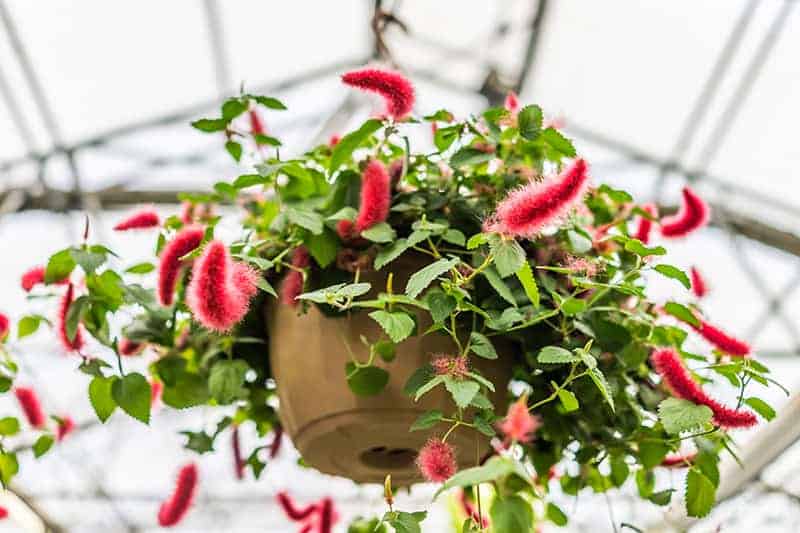
Scientific Name: Acalypha hispida
Mature Size: Up to 6 feet tall
USDA Hardiness Zone: 10-11
Light: Full sun to partial shade
Water: Maintain moist soil
Soil: Well-draining, fertile
Flower Color: Dark pink, red
Cultivars and Varieties: Dwarf Chenille Plant-Acalypha pendula, Acalypha hispida ‘Alba’
This tropical evergreen shrub is native to Malaysia and New Guinea. It produces long, soft, furry flowers that resemble fluffy animal tails. For this reason, the plant also goes by the name ‘monkey’s tail’ and ‘fox tail.’ The flowers are dark pink or bright red and fall like tassels in long strips of almost two feet long. The plant is a prolific bloomer and will produce flowers sporadically at various points throughout the year. The showy flowers have also made this a popular choice of indoor plant, and it is now cultivated worldwide as a houseplant. The foliage of the plant is ovate and large, offering a nice contrast to the dainty racemes of flowers.
It thrives on hot, humid environments, such as tropical rainforests, though it can be grown as an annual plant in warm summer climates. It works well in hanging baskets because of the trailing flowers, but can also be used as a hedge or border plant. It grows easily with a vigorous habit and prefers a rich and fertile soil.
4. Jasmine

Scientific Name: Jasminum officinale
Mature Size: Up to 30 feet tall
USDA Hardiness Zone: 7-10
Light: Full sun to partial shade
Water: Maintain moist soil
Soil: Well-draining
Flower Color: White, pink, yellow
Cultivars and Varieties: Spanish Jasmine-Jasminum grandiflorum, Showy Jasmine-Jasminum floridum, Arabic Jasmine-Jasminum sambac, Winter Jasmine-Jasminum nudiflorum
Common jasmine native to Asia, and it is a semi-evergreen or deciduous large shrub with a climbing habit. Its twining stems grow vigorously and can be trained up trellis or garden structures. The foliage of the plant is ovate and deep green, but jasmine is cultivated primarily for its beautiful and fragrant flowers. The flowers bloom in clusters in late spring or early summer. Each cluster has three to five flowers, and each flower is star-shaped with five petals. The flowers will stay in bloom until the first frost in fall, all the while giving off a heady scent. They are primarily white in color, though some varieties produce pink or pale yellow flowers.
These plants enjoy full sun or partial shade, and they like to be sheltered from harsh winds. Humidity is important for this plant, along with a continually moist, well-draining soil.
5. Bougainvillea

Scientific Name: Bougainvillea glabra
Mature Size: Up to 30 feet tall
USDA Hardiness Zone: 10-12
Light: Full sun
Water: Average water needs
Soil: Acidic, well-draining
Flower Color: Pink, orange, yellow, purple, red
Cultivars and Varieties: Bougainvillea glabra ‘Imperial Delight’, Bougainvillea glabra ‘California Gold’, Bougainvillea glabra ‘Juanita Hatten’
This evergreen climbing plant is native to South America. It is cultivated for its tiny white flowers that are surrounded by much more vibrantly colored leaf bracts. The bracts are not technically flowers, but they are thought of as the plant’s flowers, and come in a range of colors, including red, yellow, and purple.
This plant thrives in hot climates in full sun and will remain in flower for most of the year in the right conditions. In cooler climates, it will flower from spring through to fall. It also requires humidity as it would receive in its native tropical habitat, so it grows well in conservatories, though it is also cultivated as a houseplant.
Flowers are produced in clusters along the thorny stems, and eventually, give way to small berry-like fruits. Bougainvillea is fast-growing, and though it is usually trained to climb a trellis or other structures, it does not have self-clinging vines and will require support. This plant benefits from regular pruning but is best pinched just after blooming so that you don’t affect new blooms. Bougainvillea has good resistance to drought once established and can survive periods of dry soil; however, it will thrive when watered freely during hot weather.
6. Bird of Paradise

Scientific Name: Strelitzia reginae
Mature Size: Up to 6 feet tall
USDA Hardiness Zone: 10-12
Light: Full sun to partial shade
Water: Average water needs
Soil: Rich, well-draining
Flower Color: Pink, blue, orange, green
Cultivars and Varieties: Giant Bird of Paradise-Strelitzia nicolai, Narrow-leaved Bird of Paradise-Strelitzia juncea, Wild Banana-Strelitzia caudata
This evergreen perennial is native to South Africa. It forms clumps of broad foliage that grow from underground rhizomes. Leaves are gray-green in color and emerge on the end of long stalks. The plant is prized for its striking and unusual flowers that look just like swooping birds of paradise, hence the plant’s common name. Flowers are vibrantly multi-colored, with parts that are orange, blue, pink, and green. They emerge at the end of tall stalks that can reach up to six feet high. Each bloom only lasts about a week, but the plant has a good flowering period as each bloom opens up at slightly different times.
Bird of Paradise is an award-winning plant that has received the Award of Garden Merit from the Royal Horticultural Society. It thrives in rich and well-draining soil with consistent moisture, though it will tolerate periods of drought once established. It enjoys full sun or partial shade and can be grown inside as a houseplant in cooler climates. Though this plant is primarily cultivated for its tropical flowers, it is also attractive when not in bloom, thanks to its interesting foliage.
7. Blue Passion Flower

Scientific Name: Passiflora caerulea
Mature Size: Up to 30 feet tall
USDA Hardiness Zone: 6-9
Light: Full sun to partial shade
Water: Average water needs
Soil: Sandy, well-draining
Flower Color: White, blue, purple
Cultivars and Varieties: Red Passion Flower-Passiflora coccinea, Wild Passion Flower-Passiflora incarnata, Winged-stem Passion Flower-Passiflora alata
This climbing plant is evergreen in tropical climates, or deciduous in cooler environments. It is native to Brazil and Argentina where it enjoys warm temperatures, though it is surprisingly hardy and can survive in temperatures as low as 5ºF. This plant has won the Award of Garden Merit from the Royal Horticultural Society, for its noteworthy qualities. Its flowers are its most alluring feature, which bloom from early summer through to fall and measure around three inches across. They have a distinctly tropical and exotic look, with large cream petals that are partially covered by a ring of filaments in purple, white, and blue.
The flowers give way to fruits that are egg-shaped with a velvety textured orange-peach colored skin. The fruits are edible, but the plant is not cultivated for this reason specifically, as they are not particularly tasty. They are quite bland in flavor, with a slight hint of blackberry. When not in flower, the climbing plant remains attractive, with its splayed leaves that resemble the shape of hands. The stems have clinging tendrils that will grasp onto anything within their reach, but they are not invasive and will not harm structures or walls. Don’t prune the plant too heavily, as it flowers best when allowed to grow quite freely. It grows best in full sun or partial shade and thrives in sandy, well-draining soil. A fertile soil rich in organic material will result in the plant favoring foliage growth over flower production.
8. Lobster Claw

Scientific Name: Heliconia rostrata
Mature Size: Up to 6 feet tall
USDA Hardiness Zone: 10-11
Light: Full sun to partial shade
Water: Maintain moist soil
Soil: Well-draining, acidic or neutral
Flower Color: Red, pink, yellow, green
Cultivars and Varieties: Parrot Heliconia-Heliconia psittacorum, Wild Plantain-Heliconia caribaea, Christmas Heliconia-Heliconia angusta, Golden Dwarf Heliconia-Heliconia aurantiaca
This plant is a large evergreen perennial that is native to South America, and it is also the national flower of Bolivia. It produces big, strap-like leaves that are similar to that of a banana plant, and they can grow up to four feet in length. In spring and summer, flowers are produced on tall stems that can reach up to five feet in height. The vivid red or pink flowers have green and yellow tips and are shaped like lobster claws, hence the common name of the plant. These flowers are particularly attractive to butterflies, hummingbirds, and other types of birds, and are sometimes cultivated just to attract birds. Flowers last for several weeks and are also good as cut flowers. They give way to round fruits that are dark blue.
These plants thrive in full sun or partial shade and acidic or neutral well-draining soils. They need continuous moisture to perform well, and should not be allowed to dry out.
9. Maraca Ginger

Scientific Name: Zingiber spectabile
Mature Size: Up to 6 feet tall
USDA Hardiness Zone: 10-11
Light: Partial sun and partial shade
Water: Maintain moist soil
Soil: Well-draining
Flower Color: Orange
Cultivars and Varieties: Zingiber spectabile ‘Burmese Ruby’, Zingiber spectabile ‘Coffee’, Zingiber spectabile ‘Chocolate’
Also commonly known as the ‘beehive ginger,’ this plant is native to China and India, where it thrives in warm and humid environments. It thrives in environments that can replicate these conditions, such as greenhouses, or alongside a pond or stream. The plant is extremely showy and produces bracts shaped like cones. These are considered to be the flowers of the plant, though they are not technically classed as flowers. The bracts are honey-colored and appear throughout the growing season. They also make quite a statement in cut flower bouquets and have exceptional vase life.
The glossy green foliage is also attractive, but should not be given full sun as this can make the leaves turn brittle and crispy. Instead, the plant works best in dappled shade, such as planted underneath a tree with a loose canopy. Grow the plant in well-draining soil and ensure it is kept consistently moist.
10. Urn Plant

Scientific Name: Aechmea fasciata
Mature Size: Up to 3 feet tall
USDA Hardiness Zone: 10-11
Light: Partial shade
Water: Average water needs
Soil: Well-draining, sandy
Flower Color: Pink and purple
Cultivars and Varieties: Aechmea fasciata ‘Cosmic Starburst’, Aechmea fasciata ‘Charles Hodgson’, Aechmea fasciata ‘Donna Marie’, Aechmea fasciata ‘Pink Rocket’, Aechmea fasciata ‘Silver Queen’
This tropical plant belongs to the bromeliad family and is native to Brazil. It is an evergreen perennial in hot climates but is popularly grown as a houseplant in regions where the plant will not survive outside. Its foliage grows in a rosette shape, sending out broad strap-like leaves upwards and outwards, to create an urn shape, hence the plant’s common name. The foliage of this plant is very interesting. It is gray-green in color and is unevenly brushed with silver.
When the plant matures, it will send out one large pink flower bract from the center. This flower spike is covered in sharp and triangular pink bracts and filled with smaller bright purple flowers. It is a very beautiful and interesting flower, but sadly the plant only blooms once in its lifetime. It will flower at around age three years, and the bloom can last several months, but after this time, the plant will die. Around the same time, the plant will produce pups or offshoots. These can be detached from the mother plant when they are around six inches in height, and potted up separately as a means of propagation.
The plant enjoys well-draining soil that is kept slightly moist. It grows best in a partially shaded position, as it grows around the bases of trees in its natural habitat. You can also fill the urn itself with a few inches of water to keep the plant happy, but this will need to be emptied and refreshed around once a month to prevent rotting or mold.
11. Red Frangipani

Scientific Name: Plumeria rubra
Mature Size: Up to 25 feet
USDA Hardiness Zone: 10-12
Light: Full sun
Water: Low water needs
Soil: Well-draining, sand
Flower Color: Pink
Cultivars and Varieties: White Frangipani-Plumeria alba, Singapore Plumeria-Plumeria obtusa
This deciduous plant is native to Mexico and throughout Central America, as well as some countries in South America. It can be grown as a large shrub or a small tree and will spread to a similar size of its height, which ranges between five and twenty-five feet. When grown as a tree, the red frangipani takes a wide umbrella shape. It is commonly cultivated throughout tropical regions as a popular park and public garden specimen. It is also frequently seen in cemeteries and temples, and in fact, is also commonly known as the ‘temple tree’ because of this.
The tree has large, leathery foliage, with narrow leaves that can measure up to sixteen inches in length. The leaves are arranged in a spiral fashion around the branches and stems, coming to form dense clusters at the ends. The tree blooms throughout most of the year in tropical regions, producing large, pink, star-shaped flowers in clusters at the tips of branches. These flowers have an attractive fragrant and are used to make leis. In Hawaii, this tree is a commercially significant crop, where they sell tens of millions of flowers each year for lei production.
The tree thrives in full sun and has low water needs. It is drought tolerant and can survive all winter long with no moisture at all, though it should be given enough water throughout summer so that the soil has medium moisture. The red frangipani has received the Award of Garden Merit from the Royal Horticultural Society and is a much-loved specimen. It works well as a border shrub or as a specimen tree in a container. When kept in a container, it can be grown in cooler climates and brought indoors during cold months. All parts of the plant are toxic, so take care to keep it away from children and pets.
